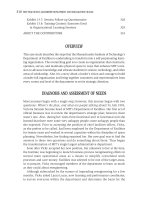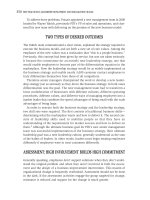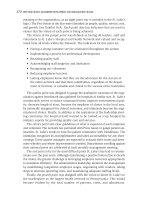Tài liệu Best Practives in Leadership Development & Organization Change 41 docx
Bạn đang xem bản rút gọn của tài liệu. Xem và tải ngay bản đầy đủ của tài liệu tại đây (155.55 KB, 10 trang )
meaning to the organization, as an eight-point star is included in the St. Luke’s
logo.) The Five Points of the Star were identified as people, quality, service, cost,
and growth (see Exhibit 16.4). Each point also has indicators that are used to
ensure that the vision of each point is being achieved.
The vision of the people point was defined as having all leaders, staff and
volunteers in St. Luke’s Hospital and Health Network feel valued and recog-
nized from all levels within the Network. The indicators for this point are
• Having a strong customer service orientation throughout the system
• Implementing a process for professional development
• Retaining quality staff
• Acknowledging staff longevity and dedication
• Recognizing our volunteers
• Reducing employee turnover
• Letting employees know that they are the advocates for the success of
the entire network and that their contribution, regardless of the depart-
ment or function, is valuable and critical to the success of the institution
The quality point was designed to gauge the qualitative successes of the orga-
nization against benchmark data gathered for hospitals of similar size. St. Luke’s
continuously strives to reduce turnaround times, improve environmental qual-
ity, decrease length of stays, become the employer of choice in the local area,
be nationally recognized for clinical outcomes, and ultimately become the orga-
nization of choice. Finally, in addition to the aspirations of the leadership steer-
ing committee, the hospital itself wanted to be ranked as a top hospital by
industry experts for providing quality care and services.
The service point sets clear guidelines of what is expected of each employee
and volunteer. The network has partnered with Press Ganey to gauge patient sat-
isfaction. St. Luke’s works to wow the patient community with friendliness. The
institution recognizes its accomplishments and takes accountability for any short-
comings. Every quarter managers are expected to evaluate their scores and deter-
mine whether and where improvement is needed. Departments excelling against
their national peers are celebrated at each monthly management meeting.
The cost point is by far the most difficult point St. Luke’s has had to commu-
nicate over the past years. Although maintaining a positive bottom line is clearly
the vision, the greater challenge is leveraging employee resources appropriately
to maximize efficiency. The administrative leadership monitors the management
by establishing competitive employee wages, negotiating with vendors, taking
steps to decrease operating costs, and maintaining adequate staffing levels.
Finally, the growth point was designed with the vision to thrust St. Luke’s in
the marketplace as the largest health network in Pennsylvania. This would
become evident by the total number of patients, visits, and admissions.
370
BEST PRACTICES IN LEADERSHIP DEVELOPMENT AND ORGANIZATION CHANGE
cart_14399_ch16.qxd 10/19/04 1:19 PM Page 370
St. Luke’s would increase revenue, volume, and market share across all entities
of the network. Looking into the future, St. Luke’s Hospital and Health Network
wishes to serve the needs of other patients in both new communities and
bordering states.
As a mechanism to illustrate the importance of the Five Points of the Star
model while continuing to develop network leaders, a series of forums was con-
ducted. The forums were designed to educate and stimulate learning with a
desired outcome of changing behaviors. Forums were presented on a regular
basis, with each session primarily focusing on one point of the star model. Orig-
inally, the intent was to have quarterly forums, but after considering the
demands placed on the steering committee to produce the forums and the time
constraints on the leaders to attend the sessions, the number of forums was
reduced to three per year. Each forum was based on the idea of incorporating
outside lecturers and presenters, coupled by internal administrators or leaders
who could implement the concepts presented by the guests while relating them
to St. Luke’s Hospital and Health Network. The net result of each forum was
that managers became knowledgeable not just of present practice but also of
other highly regarded practices away from the network. Managers had the
opportunity to evaluate and, if applicable, implement new ideas into everyday
practice.
The implementation of these regular forums constituted another change to
the St. Luke’s culture. No longer could policies and procedures alone direct the
network’s leaders. Rather, the leaders had to think, plan, and respond differ-
ently to a dynamically changing health care environment while working in
successfully growing organization.
The forums always focused on the Five Points of the Star model and provided
educational and informational content to help develop the skills of the network
leadership. The manner in which the forums were conducted fostered a casual
atmosphere that was entertaining yet informative. Presenters at these sessions
were coached to entertain and interact and avoid a lecture-type format. Attend-
ing leaders were encouraged to socialize and network with their colleagues. The
leaders often stepped out of their more conservative roles and participated in
learning exercises or even presented in a humorous fashion. This quickly
revealed the diverse talent that made up the leadership team and made for a
more enjoyable time. All of the forums were held away from the workplace to
provide a brief separation from the job and focus the attention on the learning.
Another key element to the success of the leadership forums was and remains
the consistent interjections of fun. Although fun in the workplace may not be
valuable to other corporate cultures, St. Luke’s Hospital and Health Network con-
siders this value vital to its culture. During forum planning, all members brain-
storm methods of delivering valuable learning in an environment that is both
comfortable and enjoyable to guests. This attitude stems from the senior admin-
istration that exercises this methodology on an everyday basis. Management
ST. LUKE’S HOSPITAL AND HEALTH NETWORK
371
cart_14399_ch16.qxd 10/19/04 1:19 PM Page 371
meetings commonly have a comfortable tone. In addition, St. Luke’s provides
various programs during the year to appreciate the efforts and time of its entire
staff. As important, St. Luke’s is committed to celebrating success and
recognizing its staff throughout the year. Although there are various events, the
greatest of them all is the St. Luke’s Hospital and Health Network Annual Picnic.
This day-long festival is an event that attracts over three thousand attendees. It
also includes organized team competitions for employees and their families.
Producing three quality forums a year for 260 managers has been a major
undertaking. Fortunately, the leadership steering committee was experienced at
project work and implementing major changes. The steering committee decided
to split the responsibilities up into six subgroups, thus making the process of
producing a forum more manageable. The steering committee members selected
a subgroup in which to participate and became responsible for coordinating that
part of the forum. The committee expanded some of the subgroup work by invit-
ing other managers to assist with the tasks. The subgroups would report back
to the steering committee for updates, feedback, and, at times, constructive
criticism.
The leadership steering committee would decide on which point of the star
to focus and provide a general framework for the forum, along with one or two
keynote speakers. A subgroup then worked on the content of the forum by select-
ing specific topics for the presenters and prepping them on the desired direction
and style. Another subgroup provided the decorations to support the theme and
created the ambiance of the forum. A third subgroup provided the logistical
needs and coordinated the location, the audio-visual equipment, and the food
menu. A fourth subgroup communicated weeks in advance to invite leaders to
attend, providing periodic reminders that were cleverly done and effective in
reaching everyone. Two other subgroups were formed to provide an evaluation
process and the ability to link previous, present, and future forums. The evalu-
ation tool was important not only to hear feedback but also to assess the effec-
tiveness of the leadership steering committee’s intent to educate, inform, and
change behaviors. The linkage component was critical to continually tie the
forums all back together as a process and not allow each forum to be an inde-
pendent event that was forgotten at the end of the day.
IMPLEMENTATION
The actual presentation of the leadership forums has been specifically designed
to embody the goals of the organization as a whole through the Five Points of the
Star model. In specific reference to employee satisfaction, the leadership forum
was dedicated to providing multiple programs per year that both educate and
challenge the over 260 St. Luke’s managers. Although each forum has a different
372
BEST PRACTICES IN LEADERSHIP DEVELOPMENT AND ORGANIZATION CHANGE
cart_14399_ch16.qxd 10/19/04 1:19 PM Page 372
focus, the structure is relatively the same. The morning portion is dedicated to
the guest lecturer (or presenter), who provides a presentation based on his or her
experiences away from St. Luke’s that have parallel values and applicability.
Many of the speakers share commonalities in personality and approach in that
they provide valuable learning while being charismatic, energized, and audience-
grabbing in delivery. The afternoon session involves the presentation of network
administrators and staff, who take some of the concepts presented by the guest,
and relate them to everyday challenges and opportunities within the network.
The leadership steering committee maintains the same delivery standards for its
own staff as it does for featured guests. It regularly works with and even reviews
the presentations to ensure that the audience will both learn and enjoy
from them. The successful outcome is seen in qualitative feedback received from
St. Luke’s staff indicating that these forums have made a difference in the way
they operate both as individual managers and as members of teams or
committees.
As the leadership forums approach their third full year of implementation, it
is valuable to trace back to their original development. The journey, as well
as the theme of stars for our leadership events, began on September 18, 2001,
with the “Journey to the Stars,” a kick-off event for the management team.
The scene was intentionally dramatic, with star-glittered sunglasses for all man-
agers, Star-Trek theme music, a star-studded glowing ceiling, and an agenda
emphasizing personal growth and development. The journey was “destined” to
transform managers to leaders.
The following three forums primarily focused on people, including the intro-
duction (and understanding) of the Myers Briggs Type Inventory (MBTI) and
campus-specific (hospital) satisfaction survey results (Press Ganey). Leadership
core competencies, developed in a group management approach, were intro-
duced to managers in a forum focused on the people point of the star. Additional
topics that were part of that forum included using the MBTI to assist in both
staff communications and conflict resolution. This forum illustrated to staff that
MBTI could be used to facilitate more effective conversations with various
personalities.
Subsequent leadership forums focused on three other points of the star:
service, quality, and growth. Service featured two highly successful local
company leaders who shared their blueprints for service. Dr. James Bagian, of
the Department of Veteran Affairs, presented quality in health care through
examples from his experiences as both a NASA astronaut and in implementing
process improvements of the Veterans Administration. Dr. Bagian reinforced prin-
ciples and topics that were essential for attaining positive outcomes from
qualitative excellence. In particular, he highlighted
• Health care is of the train-and-blame mentality; eliminate the “Who is at
fault?” questions as an initial response.
ST. LUKE’S HOSPITAL AND HEALTH NETWORK
373
cart_14399_ch16.qxd 10/19/04 1:19 PM Page 373
• When assessing your quality program, your starting point is your safety
program. Reason: safety systems keep you focused on the people, the
product being manufactured, and the system through which the service
or product is delivered. Keeping this focus ultimately determines the
quality outcome.
• Do a very good needs analysis in the beginning. Work on the areas that
need improvement, don’t just gather statistics around things going
wrong. This is a problem-solving, proactive approach.
• Clearly define the things you want to measure, how you will measure
them (what tools you will use), and what you will do with the data to
help improve the system.
• Don’t point the finger of blame if something fails. Treat failure as a
teachable moment, use the opportunity to learn from it and instruct
those involved in the problem. Create an environment of learning when
mistakes happen.
• Create quality review teams that are made up of people from different
disciplines.
St. Luke’s senior vice president of finance discussed the growth point of the
star. Financial growth at all campuses and as a network was highlighted.
The senior vice president of network development cleverly presented St. Luke’s
network strategic plan. Based on the game show Jeopardy, the senior vice pres-
ident of network development and colleagues reenacted the game in a humor-
ous fashion. While educating the network of particular growth facts and
strategies, mock answers were also given as a means to joke about fictional
ideas and take the occasional sarcastic “jab” at present senior administration
across the network. This format was well received regarding the quantitative
feedback and general comments received on postforum surveys. The third
speaker of the growth forum, the CEO from St. Luke’s Quakertown, made a
humorous but educational presentation called “Building a Great Place to Work.”
While highlighting programs that did work, through multiple slides and pictures
he mocked programs that were not as successful.
Although leadership forums were grand stage events, they were only held
three times per year. The leadership steering committee recognized both the
need and demand of its employees by having regular stimuli for its managers.
Therefore, the Book Club was established across the network. The foundation
principle of Book Club is to provide the managers a book that offers opportu-
nities to learn different practices and methodologies for being leaders and
employees. The concept implemented in the network was to deploy the book
to all leaders, and have regular Book Club meetings designed to create small
think tanks. Key books that have been implemented include Good to Great
1
and The Power of Full Engagement.
2
374
BEST PRACTICES IN LEADERSHIP DEVELOPMENT AND ORGANIZATION CHANGE
cart_14399_ch16.qxd 10/19/04 1:19 PM Page 374









